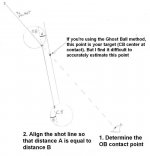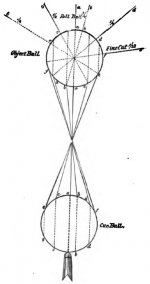Aloha all,
For what it's worth, I've never read CTE/Pro1 or anything of the sort just to set the record straight, so I don't know how anything I do relates to any other method that anybody else uses or promotes. And just to let you know, I am not selling anything or promoting anything. I'm just sharing something that I think may be useful to players who are figuring out the basics and have not settled into a style yet.
Lots of people over the years have asked me how I aim and they are startled when I tell them how simple it is (for me).
I started playing pool before my teens and then worked in a pool hall for several years until I finished high school. I started as a banger, like everyone else, and then became so good that I could beat anyone in my area when I was 15 or 16. I used to play the old timers one pocket for $100 a game in the early 70s when I was working in the pool hall because nobody would play me 9-ball. When out-of-towners came in, I got plenty of action, because everybody thought they could beat a "kid" The owner would tell me to take whatever money I needed from the cash register and play whomever wanted to play what. I won WAY more times than I lost.
While learning to play and watching, I noticed that everybody seemed to be trying to figure out how to aim, while I always thought it was relative simple. Just hit the cue ball in the same spot that you wanted to hit the object ball in order to make it go in a line to the pocket.
It is kind of hard to explain, but easy to see when shown in person. For example if I want to cut the object ball 1/8 to the left, I just hit the cue ball on the left side 1/8 from the edge with my cue tip. That way the left 1/8 of the cue ball hits the right 1/8 of the object ball. I am aligning my cue tip to the "spot" on the object ball that I want to hit. I've heard SVB explain how he aims with the "edges" of his cue and his method may be similar to mine (He tries to explain his method here: (http://www.youtube.com/watch?v=BQ-ohU0sJXE). With today's low deflection shafts, the cue ball goes "relatively" straight even if you hit off the vertical center of the cue ball. With that in mind, you can hit the cue ball from one edge to the other and it will still go straight unless you are elevating the cue which will cause swerve. When I am shooting an object ball at a 90 degree cut down a rail I am actually aiming the tip of my stick at the "EXTREME" edge of the cue ball because I want to hit the "EXTREME" edge of the object ball. The spot I am aiming at on the cue ball is a "mirror" image of the spot I want to hit the object ball, only every thing is reversed. I hit the inside edge of the cue ball in the same spot I want to hit the outside edge of the object ball. For straight in shots, it is a no brainer...center of cue ball to center of object ball. And for those of you who don't know it, straight in shots are the ONLY shots where you have a "built in" aiming reference point...the BOTTOM of the object ball. The tiny spot where the ball touches the table is the exact center of the ball...look below the ball at the table and aim at that SPOT...not the object ball itself.
One of the things you will quickly notice when you use this method is that you are aiming at the "inside" of the cue ball all the time when you are aiming. If you want to put a bit of outside, you adjust your whole cue over just a bit after you have made your alignment.
For lack of knowing what this method is called, I call it "Contact Point To Contact Point" aiming. I'll even give it a fancy acronym like "CP2CP" so it will sound like something special and important, but it is actually SIMPLE and ACCURATE.
The other day, one of the guys in the pool hall asked me if I was over 60 yet and I asked why and he said he didn't see many 60 year old guys running racks too often. I had just put a 5-pack on him and then made the 9 on the break in the 6th game and scratched. Shortly after that, I put a 3-pack on him and then made the 9 on the break again and scratched. It is getting harder and harder to run those at my age, but having made my game as "simple" as possible it makes it a bit easier to do than if I was trying to figure out where to aim every shot.
This method may not be for everyone, but it works for me.
For what it's worth, I've never read CTE/Pro1 or anything of the sort just to set the record straight, so I don't know how anything I do relates to any other method that anybody else uses or promotes. And just to let you know, I am not selling anything or promoting anything. I'm just sharing something that I think may be useful to players who are figuring out the basics and have not settled into a style yet.
Lots of people over the years have asked me how I aim and they are startled when I tell them how simple it is (for me).
I started playing pool before my teens and then worked in a pool hall for several years until I finished high school. I started as a banger, like everyone else, and then became so good that I could beat anyone in my area when I was 15 or 16. I used to play the old timers one pocket for $100 a game in the early 70s when I was working in the pool hall because nobody would play me 9-ball. When out-of-towners came in, I got plenty of action, because everybody thought they could beat a "kid" The owner would tell me to take whatever money I needed from the cash register and play whomever wanted to play what. I won WAY more times than I lost.
While learning to play and watching, I noticed that everybody seemed to be trying to figure out how to aim, while I always thought it was relative simple. Just hit the cue ball in the same spot that you wanted to hit the object ball in order to make it go in a line to the pocket.
It is kind of hard to explain, but easy to see when shown in person. For example if I want to cut the object ball 1/8 to the left, I just hit the cue ball on the left side 1/8 from the edge with my cue tip. That way the left 1/8 of the cue ball hits the right 1/8 of the object ball. I am aligning my cue tip to the "spot" on the object ball that I want to hit. I've heard SVB explain how he aims with the "edges" of his cue and his method may be similar to mine (He tries to explain his method here: (http://www.youtube.com/watch?v=BQ-ohU0sJXE). With today's low deflection shafts, the cue ball goes "relatively" straight even if you hit off the vertical center of the cue ball. With that in mind, you can hit the cue ball from one edge to the other and it will still go straight unless you are elevating the cue which will cause swerve. When I am shooting an object ball at a 90 degree cut down a rail I am actually aiming the tip of my stick at the "EXTREME" edge of the cue ball because I want to hit the "EXTREME" edge of the object ball. The spot I am aiming at on the cue ball is a "mirror" image of the spot I want to hit the object ball, only every thing is reversed. I hit the inside edge of the cue ball in the same spot I want to hit the outside edge of the object ball. For straight in shots, it is a no brainer...center of cue ball to center of object ball. And for those of you who don't know it, straight in shots are the ONLY shots where you have a "built in" aiming reference point...the BOTTOM of the object ball. The tiny spot where the ball touches the table is the exact center of the ball...look below the ball at the table and aim at that SPOT...not the object ball itself.
One of the things you will quickly notice when you use this method is that you are aiming at the "inside" of the cue ball all the time when you are aiming. If you want to put a bit of outside, you adjust your whole cue over just a bit after you have made your alignment.
For lack of knowing what this method is called, I call it "Contact Point To Contact Point" aiming. I'll even give it a fancy acronym like "CP2CP" so it will sound like something special and important, but it is actually SIMPLE and ACCURATE.
The other day, one of the guys in the pool hall asked me if I was over 60 yet and I asked why and he said he didn't see many 60 year old guys running racks too often. I had just put a 5-pack on him and then made the 9 on the break in the 6th game and scratched. Shortly after that, I put a 3-pack on him and then made the 9 on the break again and scratched. It is getting harder and harder to run those at my age, but having made my game as "simple" as possible it makes it a bit easier to do than if I was trying to figure out where to aim every shot.
This method may not be for everyone, but it works for me.
Last edited:

